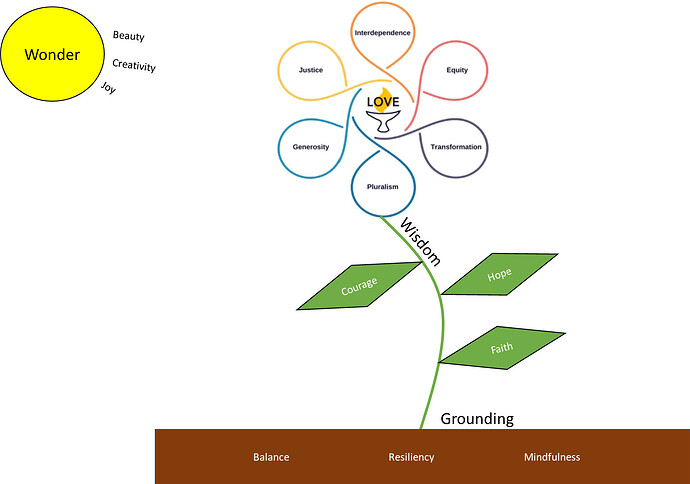Submission 290
Jennifer Courtwright
First Unitarian Universalist Church of San Antonio (San Antonio, TX) 7834
What is your suggestion or idea?
Inspirations As a pluralistic, living religious
tradition, we draw inspiration from our direct lived experiences as well as our
historical religious ancestries. We use the term religious because the root of
the word is religare which means to re-bind. Our central task as a
religious community is therefore to unveil and repair the bonds that bind each
to all and to feel a part of something larger than ourselves. These experiences of connection, wonder, and
mystery open our hearts, renew our spirits, and provide wisdom, hope, and
grounding critical for living out our shared values. A living tradition needs
inspirations to persist, flourish, and evolve with our changing world. Just as
the diversity of biological communities is critical to surviving change, the
diversity of sacred and secular understandings which enrich our faith is our
strength. This diversity includes but is not limited to:Sources of energy which spark wonder and
joy
Direct personal experience of
that transcending mystery and wonder, affirmed in all cultures, which
moves us to a renewal of the spirit and an openness to the forces which
create and uphold life;
Examples of ordinary people doing
extraordinary acts of compassion and kindness;
Collective effervescence. Shared
experiences with large groups of people (e.g.
worship services, music concerts, political rallies) which promote joy, healing, and expanding benevolence;
Hospitality which nourishes our
spirit and our bodies;
Laughter, play, and friendships which help us find our true selves,
belonging, and make us feel more alive
Sources of wisdom which provide
courage, hope, and faith
Direct knowledge perceived by our
bodies, minds, emotions, and spirit;
Wisdom from the world’s religions
and philosophies which provide many paths for finding meaning in our
lives;
The long arc of the moral
universe through time and the words and deeds of prophetic people which
challenge us to confront powers and structures of evil with justice,
compassion and the transforming power of love;
Sacred and secular teachings
which call us to have humility and love our neighbors as ourselves;
Humanist teachings which stress
the importance of reason and embodied ethics in the here and now;
Scientific understandings of the
natural world which help us live the questions, deal with uncertainty,
unveil relationships, and provide examples of creativity and resiliency of
biotic communities;
Spiritual teachings of
Earth-centered traditions which complement ecological understandings of
the natural world, teach us the reciprocal nature of relationships, and
celebrate the sacred circle of life;
Myths, art, poetry, dance and
music which help us feel and express the ineffable;
Stories of resiliency of the human spirit and adaptation to our
changing world
Sources of grounding which provide
balance and restoration
Ritual which brings historical wisdom
to life and creates shared sacred time and space;
Mindfulness practices found in
all sacred and secular traditions. These practices may take the form of
personal or communal practices and may be of the body, mind, and/or
spirit;
Sacred rest. Just as there is day
and night and cycles of seasons, our spirit too needs rest and routines to
help us make meaning;
Difficult times which help us appreciate joyous times. Just as fire
can be a source of destruction and energy so too can difficult times be an
inspiration for new paths forward.
We respect the histories, contexts and
cultures in which these understandings were created and are currently
practiced, and we are called to ever deepen and expand our wisdom.
What is the reason for your amendment idea?
We feel that the Article II Commission’s proposal is too
generic to be meaningful and lacking in inspiration. Any statement of our
inspirations should truly be inspiring and have wonder and hope at the center.
We very much appreciate the #14 Amendment Idea proposed by Matthew Johnson and
others which centers wonder but think that we could go further and also center
other aspects of our inspirations such as wisdom and grounding. Following the
Commission’s recommendations, we focused our revisions on what our inspirations
do for us. Based on this, we were able to identify three large groups of
inspirations/sources: sources that provide energy, wisdom, and grounding. We
additionally felt like it was important to articulate what a living religious
tradition is and does and further connect the inspirations to the values. We
feel that the sources/ inspirations are currently overlooked in many aspects of
our faith except in religious education. Omitting detail about our inspirations
from our bylaws is likely to further lead to omission of this critical aspect
of our faith, and detailed articulations of our inspirations are critical for
religious education. The same rationale the Commission has given for not
including a list of sources could be used to not include a list of values
either. While we recognize that our proposal brings back a list and
significantly increases the length of this section, we attempted to create as
comprehensive a list as possible and would very much be interested in
collaborating with others to express this list in graphical art. For example,
we could envision our proposal pairing well with the flower of our values,
where sources of energy are represented by the sun, the sources of wisdom are
the flowers roots, and the sources of grounding are the ground the flower is
rooted in.
Have you discussed this idea with your congregation or other UUs?
Yes, we had a series of classes and discussions on this amendment at First UU San Antonio and we conducted a congregation wide survey. 70% of respondents to the survey (48 out of 69 individuals) were in favor of this amendment, which was comparable to the proportion of individuals in favor of other aspects of article II revisions. Additionally, we have collaborated with the minister of Chequamegon Unitarian Universalist Fellowship of Ashland, WI, Stacy Craig, and she is also in favor of this amendment.


